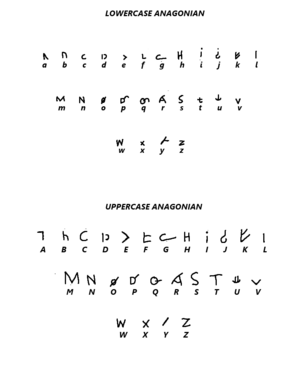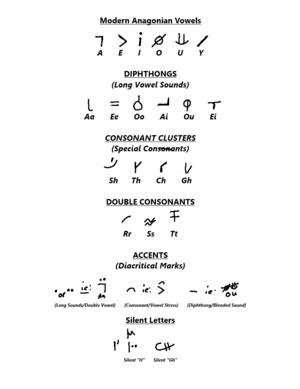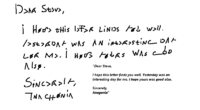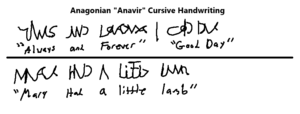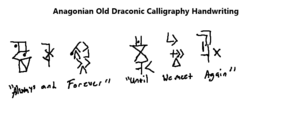History of the Modern Anagonian Script Language: Difference between revisions
(Created page with "{{region_icon_Esvanovia}} thumb|right|The Modern Anagonian Alphabet; Seurian influence is clearly seen here with modern letters incorporated, alongside the more modernized Draconic script symbols that eventually evolved over time. The evolution of the Modern Anagonian Script is deeply rooted in the tumultuous history of Anagonia, particularly following the influence of the Seurian invasion over two millennia ago. Before the arrival of...") |
|||
| (One intermediate revision by the same user not shown) | |||
| Line 59: | Line 59: | ||
By maintaining a balance between the ancient Anagonian scripts and the widely used Seurian, Anagonia ensures that its people are well-equipped for both preserving their cultural identity and engaging in global diplomacy. | By maintaining a balance between the ancient Anagonian scripts and the widely used Seurian, Anagonia ensures that its people are well-equipped for both preserving their cultural identity and engaging in global diplomacy. | ||
===Anagonian Calligraphy and Artistic Writing=== | |||
The Anagonian language has a long-standing tradition of calligraphy and artistic writing, where the beauty of the script becomes a form of expression in itself. The Old Draconic Script, with its sharp, claw-like markings, has been adapted over the centuries into ceremonial and decorative forms that highlight both cultural heritage and the evolution of artistic practices in Anagonia. | |||
====Modern Anagonian Script and "Cursive" Writing==== | |||
[[File:AnagonianCursiveAnavirHandwriting1.png|thumb|right|A few examples of "Anavir" cursive handwriting, taught in most school curriculums and usually used for professional purposes.]] | |||
In modern times, the Anagonian script has further evolved to include a flowing, connected form of writing that resembles what is known in other cultures as cursive. This style, referred to as "'''Anavir'''" in Anagonian, allows for the continuous flow of characters in a single, fluid motion, often used for personal correspondence, invitations, and artistic writing. | |||
The development of Anavir was a response to the need for quick and efficient writing, especially in everyday contexts like letter-writing, journaling, and signatures. While formal Modern Anagonian Script retains its structured, angular nature, Anavir prioritizes speed and fluidity, linking letters with smooth curves and avoiding the sharp breaks seen in the traditional script. | |||
In government documents and legal contexts, Anavir is generally not used, as the formal script remains the preferred method. However, in private use, particularly in more artistic or informal settings, Anavir is widely popular. Calligraphers have taken this cursive-like script to new heights, incorporating flourishes and embellishments to create elegant pieces of written art, combining both function and beauty. | |||
====Ceremonial Uses of Calligraphy==== | |||
[[File:AnagonianOldDraconicHandwriting1.png|thumb|left|A few examples of Old Draconic Calligraphy Handwriting, typically used for special occasions and rarely used outside of Anagonian purposes.]] | |||
In formal ceremonies, such as religious rituals or state events, the use of Old Draconic Script remains a highly respected tradition. Drekanity priests are often trained in the art of calligraphy to ensure the sacred texts and prayers are written with precision and care. These scripts are usually carved into stone tablets, inscribed onto ceremonial scrolls, or engraved on monuments, serving as eternal symbols of ancestral reverence and the divine connection between Anagonians and their draconic past. | |||
In governmental settings, Anagonian calligraphy is sometimes used on official documents, such as treaties or declarations, to imbue them with cultural significance. These documents often incorporate a mix of Modern Anagonian Script for the text itself, with Draconic calligraphy used for the headings or signatures, marking the document as both functional and symbolic. | |||
====Artistic Writing in Modern Times==== | |||
Scholars and artists have taken the Old Draconic Script and adapted it for modern artistic purposes. This practice, known as Draconic Revivalism, incorporates elements of the ancient script into contemporary visual art, sculpture, and tattoos. The angular, bold strokes of the script are often used to create pieces that convey a sense of power and history while remaining aesthetically modern. | |||
In street art and urban spaces, younger generations have embraced Draconic-inspired calligraphy as a way of reconnecting with their roots. Murals often feature stylized versions of both Old Draconic and Modern Anagonian Script, blending tradition with a more free-form, expressive style. | |||
====Adaptation of Draconic Script for Decoration==== | |||
While the original Old Draconic Script was utilitarian and focused on practicality, its modern adaptation has evolved into a more decorative art form. Scrollwork, flourishes, and intricate patterns are commonly added to the angular script, transforming it into an art form seen in temples, government buildings, and even private homes. | |||
Ceremonial swords, jewelry, and textiles often feature Draconic calligraphy, symbolizing strength, wisdom, or protection. These artistic representations of the language go beyond mere communication—they become talismans of Anagonian identity. | |||
====Calligraphy as Cultural Expression==== | |||
For many Anagonians, the act of practicing calligraphy is a spiritual and meditative experience, with each stroke of the pen or brush serving as a link to their ancestors. Cultural festivals and educational programs often feature calligraphy workshops, teaching younger generations the art of ceremonial writing as a way of preserving this important aspect of Anagonian culture. | |||
===Evolution of the Written Script=== | ===Evolution of the Written Script=== | ||
Latest revision as of 21:14, 6 October 2024
The evolution of the Modern Anagonian Script is deeply rooted in the tumultuous history of Anagonia, particularly following the influence of the Seurian invasion over two millennia ago. Before the arrival of Seurian forces, Anagonian society was primarily shaped by the ancient Draconic Script—a language that reflected the dragons' territorial, ritualistic, and practical needs. As Anagonia grew, this primitive yet powerful form of communication served as the foundation for early human and non-human interactions, with its rough and guttural sounds shaping the nature of Anagonian speech.
However, the Seurian invasion around 388 BCE introduced a new linguistic paradigm. The Seurians, with their more structured and refined language, brought with them a written script that was markedly different from the Anagonians’ draconic-influenced methods of communication. As Anagonia emerged victorious from the war with Seuria, scholars and scribes began studying the intricacies of the Seurian language and script, noticing the striking similarities to the ancient claw marks of the Draconic Script. This sparked a gradual and slow adaptation process, as Anagonian society assimilated elements of the Seurian script into their own, while still preserving the cultural and historical ties to their draconic origins.
Post-Seurian Influence and the Era of Empires
The formalization of the Mal-Videnus Commonwealth in 110 BCE, under the leadership of General Octavius Mavidenus, marked a pivotal moment for the evolution of the Anagonian script. The unification of Anagonia’s city-states under the Commonwealth led to the establishment of standardized systems of governance, trade, and communication. This era saw the integration of Seurian language structures into Anagonia’s official records and writings, with many scribes adopting Seurian methods for documenting military achievements, territorial expansions, and cultural developments.
During this period, hybrid scripts began to emerge, blending the direct, forceful strokes of the Draconic Script with the more flowing, organized structure of Seurian writing. This fusion allowed for more complex sentence structures and easier communication between the various human and non-human populations within the Commonwealth. The emphasis on territorial control, once a key feature of draconic inscriptions, evolved into a bureaucratic tool for recording land claims, taxes, and trade agreements. By the time the First Mal-Videnus Commonwealth collapsed in 20 BCE, the Anagonian script had transformed into something much more reflective of the dynamic and evolving society.
From Commonwealth to Kingdom
As Anagonia transitioned from the Mal-Videnus Commonwealth to the First Kingdom of Anagonia in 1100 CE, the evolving script became more entrenched in daily life, administration, and governance. The House of Valdor, under the leadership of Aldric Valdor I, sought to consolidate power across the fractured lands of Anagonia. To manage the vast territories and ensure clear communication between the central government and outlying regions, the modernized version of the Anagonian script became crucial.
During this era, the Seurian influence on the script was fully integrated into the bureaucratic systems. The Valdor monarchy enforced a standardized written script, which was now more fluid and adaptable than the original Draconic Script. This was necessary for the growing needs of the kingdom: managing trade, diplomacy, and military logistics, while also maintaining the spiritual significance of the written word in rituals and legal documents. The hybridization process accelerated as scribes and scholars throughout the kingdom refined the script to better suit the kingdom’s growing complexity.
At this point, the Modern Anagonian Script took on its definitive form, with:
- Vertical and horizontal combinations of symbols becoming rarer, replaced by a more linear, flowing style for ease of reading and writing.
- Numerical systems, once limited to basic dot and slash combinations, becoming fully developed. The introduction of Seurian-inspired numerical characters allowed for more complex accounting and administrative work.
- Punctuation marks becoming more common, ensuring clearer communication in legal texts and treaties, while retaining certain claw-mark aesthetics from the older Draconic Script.
This period also saw the rise of literature and philosophy, both of which relied on the script for widespread dissemination. While many of these works focused on the virtues of the Valdor monarchy or the philosophical musings of the time, they also preserved the mythical connection Anagonia had with dragons, a theme that continued to influence the language’s tone and structure.
Transition to the United Republic
The fall of the Valdor monarchy and the subsequent rise of the United Republic of Anagonia in 1362 CE marked another turning point for the Anagonian language and script. With the establishment of a federal system and democratic governance, the need for clear and standardized communication became more critical than ever. This period saw the final steps in the evolution of the Modern Anagonian Script, ensuring that it could serve both the complex legal system and the cultural diversity of Anagonia’s various states and territories.
Under the United Republic, the modern script became the de facto standard for all forms of communication, from state decrees to literary works. It was during this time that the script also became associated with the symbolism of unity—a way of bringing together the disparate provinces of Anagonia under a single cultural and administrative umbrella. Scholars of the time emphasized the script’s flexibility and efficiency, noting that its dual origins in both draconic and Seurian traditions reflected Anagonia’s broader cultural heritage.
The Seurian numeric system was also further refined during this era, incorporating elements from the Draconic method of representation, particularly for large sums or complex calculations. This allowed for more efficient taxation systems, military logistics, and even early forms of scientific notation, laying the groundwork for technological advancements in later centuries.
Post-Great War and Modern Era
Following the conclusion of the Great War in 1951 CE, Anagonia emerged as a powerful and unified state, now known as the Confederate States of Anagonia. The post-war era was marked by rapid modernization, particularly in the fields of industry, technology, and governance. The Modern Anagonian Script, now fully developed, served as the backbone of this growth, as the nation expanded its global influence and solidified its internal cohesion.
In the modern era, the script has continued to evolve, though its core structure remains intact. The Confederate government maintains close ties with academic institutions to ensure that the language remains consistent across the nation, while also allowing for technological adaptations, such as digital fonts and formalized typing systems. The script, while deeply rooted in its ancient heritage, has adapted to suit modern communication methods, from print to digital media.
Key aspects of the modern script include:
- Simplified punctuation for ease of use in international communication, while still retaining subtle claw-mark influences in stylistic choices.
- The ability to convey complex scientific and mathematical concepts, reflecting the script's adaptability and versatility in an era of technological advancement.
- Preservation efforts for the older draconic and Seurian elements, ensuring that the historical aspects of the language remain intact while allowing for modern usage.
Language Education in Modern Anagonia
In the contemporary period, schools and universities across Anagonia ensure that future generations remain connected to their linguistic heritage by teaching the history of the Anagonian script as part of the standard curriculum. Students are introduced to both the Draconic Script and the Modern Anagonian Script, learning how each played a role in shaping the nation's identity. The Draconic Script, while no longer used in everyday communication, is still valued for its ceremonial and symbolic importance. Pilgrimages and religious texts continue to feature the ancient symbols, preserving their relevance in modern Anagonian culture.
However, the Modern Anagonian Script is the primary medium for governance, law, and daily communication, reflecting the evolution of the language over centuries.
Cultural and Artistic Impact on Anagonian Language
The Anagonian language has been deeply influenced by its rich cultural and artistic traditions. Literature, poetry, and music have played an essential role in the development of the language, particularly in shaping its expressive vocabulary. The mystical connection to dragons, along with the ancient myths and legends passed down through generations, has led to a host of idiomatic expressions tied to strength, wisdom, and nature. For instance, phrases like "the roar of a dragon" are often used to describe someone speaking with great authority or intensity.
Poetry, especially, has pushed the limits of the language’s rhythmic and lyrical qualities, drawing influence from ancient chants and rituals. Modern Anagonian poetry has embraced these elements, using the fluidity of the language to craft works that celebrate the nation's history, spiritual beliefs, and connection to the natural world.
Seurian: Diplomatic and International Relevance
In addition to learning about the Anagonian language, students are also required to study Seurian, the primary diplomatic language used across Esvanovia. Given its importance as the universal diplomatic language, all official international correspondence, treaties, and diplomatic documents are written or translated into Seurian. This language plays a critical role in historical archiving and is essential for maintaining proper diplomatic relations with other nations within the region.
As such, the curriculum in modern Anagonian schools includes comprehensive instruction in Seurian grammar, syntax, and usage. Students are trained in the language from a young age, as proficiency in Seurian is considered crucial for careers in government, diplomacy, and international relations.
By maintaining a balance between the ancient Anagonian scripts and the widely used Seurian, Anagonia ensures that its people are well-equipped for both preserving their cultural identity and engaging in global diplomacy.
Anagonian Calligraphy and Artistic Writing
The Anagonian language has a long-standing tradition of calligraphy and artistic writing, where the beauty of the script becomes a form of expression in itself. The Old Draconic Script, with its sharp, claw-like markings, has been adapted over the centuries into ceremonial and decorative forms that highlight both cultural heritage and the evolution of artistic practices in Anagonia.
Modern Anagonian Script and "Cursive" Writing
In modern times, the Anagonian script has further evolved to include a flowing, connected form of writing that resembles what is known in other cultures as cursive. This style, referred to as "Anavir" in Anagonian, allows for the continuous flow of characters in a single, fluid motion, often used for personal correspondence, invitations, and artistic writing.
The development of Anavir was a response to the need for quick and efficient writing, especially in everyday contexts like letter-writing, journaling, and signatures. While formal Modern Anagonian Script retains its structured, angular nature, Anavir prioritizes speed and fluidity, linking letters with smooth curves and avoiding the sharp breaks seen in the traditional script.
In government documents and legal contexts, Anavir is generally not used, as the formal script remains the preferred method. However, in private use, particularly in more artistic or informal settings, Anavir is widely popular. Calligraphers have taken this cursive-like script to new heights, incorporating flourishes and embellishments to create elegant pieces of written art, combining both function and beauty.
Ceremonial Uses of Calligraphy
In formal ceremonies, such as religious rituals or state events, the use of Old Draconic Script remains a highly respected tradition. Drekanity priests are often trained in the art of calligraphy to ensure the sacred texts and prayers are written with precision and care. These scripts are usually carved into stone tablets, inscribed onto ceremonial scrolls, or engraved on monuments, serving as eternal symbols of ancestral reverence and the divine connection between Anagonians and their draconic past.
In governmental settings, Anagonian calligraphy is sometimes used on official documents, such as treaties or declarations, to imbue them with cultural significance. These documents often incorporate a mix of Modern Anagonian Script for the text itself, with Draconic calligraphy used for the headings or signatures, marking the document as both functional and symbolic.
Artistic Writing in Modern Times
Scholars and artists have taken the Old Draconic Script and adapted it for modern artistic purposes. This practice, known as Draconic Revivalism, incorporates elements of the ancient script into contemporary visual art, sculpture, and tattoos. The angular, bold strokes of the script are often used to create pieces that convey a sense of power and history while remaining aesthetically modern.
In street art and urban spaces, younger generations have embraced Draconic-inspired calligraphy as a way of reconnecting with their roots. Murals often feature stylized versions of both Old Draconic and Modern Anagonian Script, blending tradition with a more free-form, expressive style.
Adaptation of Draconic Script for Decoration
While the original Old Draconic Script was utilitarian and focused on practicality, its modern adaptation has evolved into a more decorative art form. Scrollwork, flourishes, and intricate patterns are commonly added to the angular script, transforming it into an art form seen in temples, government buildings, and even private homes.
Ceremonial swords, jewelry, and textiles often feature Draconic calligraphy, symbolizing strength, wisdom, or protection. These artistic representations of the language go beyond mere communication—they become talismans of Anagonian identity.
Calligraphy as Cultural Expression
For many Anagonians, the act of practicing calligraphy is a spiritual and meditative experience, with each stroke of the pen or brush serving as a link to their ancestors. Cultural festivals and educational programs often feature calligraphy workshops, teaching younger generations the art of ceremonial writing as a way of preserving this important aspect of Anagonian culture.
Evolution of the Written Script
The evolution of the Anagonian written script reflects the nation's long journey from its draconic roots to the modern digital age. Originally, the Draconic Script was carved into stone by dragons and early Anagonian societies, primarily for ritualistic and territorial purposes. The script’s sharp lines, resembling claw marks, were ideal for marking sacred places and defining boundaries. As Anagonia’s society advanced, this script adapted to new materials like clay tablets and primitive parchment, before eventually evolving into more refined forms suited for paper. Over time, the script changed to meet the growing needs of a more complex society, particularly in governance, trade, and education.
Key milestones in the development of the Modern Anagonian Script include:
- The Seurian Invasion: The introduction of Seurian writing during the Seurian invasion marked a significant turning point. The more structured, linear writing system of the Seurians provided Anagonia with a clearer, more versatile script. Seurian influence helped simplify the previously complex, symbol-heavy Draconic Script, making it more efficient for day-to-day use, particularly in matters of state and diplomacy.
- Formation of the Mal-Videnus Commonwealth: With the rise of the Mal-Videnus Commonwealth, Anagonia needed a unified script to standardize communication across its various provinces and territories. This led to the creation of a formalized script that balanced the aesthetic beauty of its ancient origins with the practicality required for military, diplomatic, and economic correspondence. The Mal-Videnus Commonwealth effectively set the standard for written Anagonian, shaping the foundations of what is now considered the modern script.
- Industrial and Digital Revolutions: The industrial revolution further transformed the script, as mass printing required a more standardized and simplified form of writing. This transition was especially evident in the fields of engineering, machinery, and transportation, where technical manuals and documents needed to be easily readable. Later, the digital revolution adapted the script even further for use in computers, mobile devices, airplanes, and other advanced technological platforms. Modern digital fonts were created to reflect the essence of the script, while ensuring compatibility with modern software and interfaces, maintaining a balance between tradition and functionality.
The Anagonian written script, from its early roots in sacred draconic markings to its place in the digital age, remains a symbol of the nation's ability to adapt and innovate while preserving its rich heritage.
